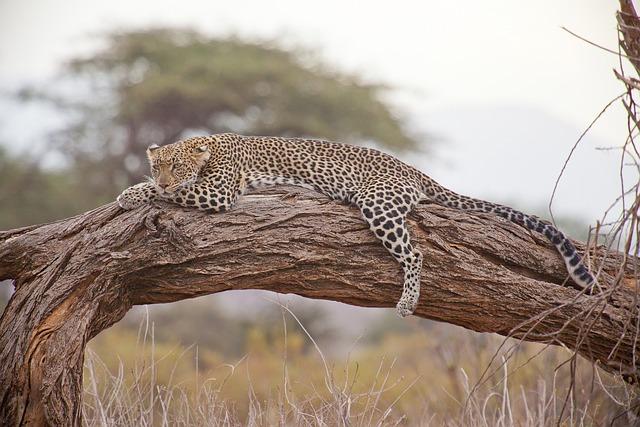In a significant pivot in railway financing, kenya is now seeking support from the United Arab Emirates (UAE) after China, previously a dominant investor in the East African nation’s infrastructure projects, scaled back its funding commitments. This shift underscores the evolving landscape of international investments in Africa, where the need for robust transportation networks remains critical for economic growth and connectivity. As Kenya grapples with budgetary constraints and ambitious infrastructure plans, the decision to turn to the UAE not only highlights a potential new financial partnership but also raises questions about the future direction of investment flows in the region. In this article, we explore the implications of this shift, the strategic motives behind Kenya’s move, and the broader context of international funding in African infrastructure development.
Kenya’s Shift in Funding Strategy for Railway Projects
in a strategic pivot away from reliance on Chinese financing, Kenya has initiated discussions with the United Arab Emirates (UAE) to secure funding for its ongoing railway projects. This shift comes in response to china’s recent decision to cut off financing,leaving the East African nation seeking alternative sources to support its ambitious transport infrastructure plans. The UAE’s interest in Kenyan railways is indicative of its broader regional investment strategy, which aims to strengthen economic ties and enhance connectivity across Africa.
Key factors driving this new financial collaboration include:
- Infrastructure Development: Enhancing logistical capabilities to boost trade and economic growth.
- Mutual Benefits: The UAE seeks to expand its investment portfolio, while Kenya aims for sustainable growth through modern transport networks.
- Geopolitical Dynamics: As global funding landscapes evolve, Kenya is diversifying its funding sources to mitigate risks related to single-country dependencies.
| Funding Source | current Status | Investment Focus |
|---|---|---|
| China | reduced financing | major infrastructure projects |
| UAE | Negotiating | Railway expansion and modernization |
Impact of China’s Withdrawal on Kenya’s Infrastructure Development
The recent decision by China to withdraw its financial support for infrastructure projects in Kenya has created significant ripples in the country’s development strategies. This shift compels the Kenyan government to reassess its funding sources and allied partnerships, particularly in the realm of railway expansion, which is critical for economic growth. The ramifications of this withdrawal may lead to:
- Delays in ongoing infrastructure projects
- Increased reliance on alternative financing entities
- Potential shifts in project specifications to align with new funding requirements
As Kenya turns its gaze towards the UAE for assistance,this transition may pave the way for new investment opportunities. Engaging with different international partners coudl foster a more diversified funding landscape. however, this also raises critical questions regarding:
- Alignment of project timelines and expectations with UAE stakeholders
- Possible shifts in the strategic priorities of the Kenyan government in infrastructure planning
- Impact on cost and quality controls in the sense of new partnerships
| Funding Source | Impact on Infrastructure |
|---|---|
| China | Reduced funding for current and future projects |
| UAE | Potential for new funding but with different priorities |
Exploring UAE’s Investment Potential in African Railways
As African nations seek to expand their railway infrastructures, the UAE has emerged as a pivotal player in funding these ambitious projects. With Kenya’s recent pivot toward Emirati investment following reductions in Chinese financing, the potential for collaboration between the UAE and African countries is becoming increasingly evident.The investment strategy of the UAE focuses on creating mutually beneficial outcomes that assist in modernizing rail transport, thereby fostering regional trade and connectivity. The emphasis on sustainable development aligns with the UAE’s vision for diversifying its investment portfolio and enhancing its role in Africa’s economic conversion.
Moreover, investing in African railways presents several opportunities for the UAE. The key factors contributing to this trend include:
- Strategic Partnerships: Collaborating with local governments and private sectors to leverage expertise and resources.
- Infrastructure Development: Modernizing outdated transport systems to support rapid urbanization and economic growth.
- Regional Stability: Promoting peace and security through improved transportation links,boosting trade between neighboring countries.
| Investment focus | Potential Benefits |
|---|---|
| Modernized Rail Systems | Increased trade efficiency and reduced travel times |
| Public-Private Partnerships | Attract diverse funding sources and expertise |
| Local Job Creation | Boosting employment and skill development in the region |
Challenges and Opportunities in Securing UAE Financing
Securing financing from the UAE presents both hurdles and pathways for Kenya as it pivots away from traditional sources like China. One of the primary challenges lies in navigating the complex regulatory landscape that governs foreign investments in the UAE. Kenyan officials must forge trust with UAE stakeholders while ensuring compliance with stringent financial protocols. Additionally, the intense competition among nations seeking UAE funding can complicate negotiations, as the Emirati market becomes increasingly saturated with various international projects vying for attention. Economic fluctuations and changing geopolitical dynamics further exacerbate these challenges,possibly affecting the availability and terms of financing.
Tho,despite these obstacles,several opportunities arise in this partnership. UAE investors are often drawn to infrastructure projects, recognizing their long-term profitability and strategic importance. The possibility for public-private partnerships (PPPs) in railway development can be particularly appealing, leveraging both Kenyan resources and emirati capital and expertise. Furthermore, collaboration with the UAE could also open avenues for technology transfer and knowledge sharing, enhancing the efficiency and safety of railroad infrastructure. a successful engagement could not only secure essential funding but also strengthen bilateral relations between Kenya and the UAE.
Strategies for Kenya to Strengthen Economic Ties with the UAE
To enhance its economic relationship with the UAE, Kenya can implement a series of strategic initiatives focused on mutual benefits and synergies. Increasing bilateral trade is crucial, and Kenya could identify key export sectors such as agricultural products, textiles, and technology. This could be complemented by launching trade missions and business expos aimed specifically at UAE investors, showcasing opportunities in various industries. Additionally, promoting direct flights and trade facilitation shoudl be prioritized, as improved connectivity woudl streamline logistics and encourage business interactions.
Furthermore, Kenya should explore joint ventures and public-private partnerships that leverage the UAE’s investment capabilities in infrastructure development, particularly in the transport and logistics sectors. This collaboration could attract UAE investment, particularly in railway systems and ports, enhancing Kenya’s strategic positioning as a trade hub in East Africa. Establishing investment promotion agencies focused on targeting UAE businesses, coupled with incentives for foreign investors, can also catalyze further economic collaboration. the table below illustrates potential sectors for collaboration between kenya and the UAE:
| Sector | Opportunities |
|---|---|
| Agriculture | Export of fresh produce and investment in agro-technology |
| Tourism | joint marketing campaigns and holiday packages |
| Energy | Collaborative renewable energy projects |
| Real Estate | Investment in housing and commercial developments |
Future Prospects for Rail Connectivity in East Africa
As Kenya seeks new partnerships for its railway development projects,the shift towards collaboration with the United Arab Emirates (UAE) highlights a significant pivot in East Africa’s infrastructure strategy.The region’s transportation network is increasingly recognized as vital for economic growth,particularly as countries embark on ambitious plans to enhance connectivity. The UAE’s investment potential is appealing for several reasons:
- Financial Resources: The UAE has a robust investment capability and a history of financing large-scale infrastructure projects.
- Expertise in Modern Technology: The UAE’s experience with cutting-edge rail systems can offer guidance in developing efficient operations.
- Strengthening Trade Links: Closer ties can open up new markets for East African goods, bolstering regional trade.
The long-term vision for railway connectivity in East Africa, especially in light of fluctuating foreign investments, necessitates a resilient approach to funding and partnerships. The anticipated benefits of enhanced rail systems include:
| Benefits of Enhanced Rail Connectivity | Impact on east Africa |
|---|---|
| increased Efficiency | Streamlined transport of goods and people. |
| Job Creation | Employment opportunities in construction and operations. |
| Reduced Travel Time | Improved logistics for businesses and commuters. |
| Environmental Benefits | Shift towards more sustainable transport options. |
By leveraging the financial prowess of the UAE while also cultivating local capacities, east african nations can ensure that their railway systems not only meet immediate transportation needs but also contribute to broader socio-economic goals. The interplay of global investment strategies will undoubtedly shape the landscape of rail connectivity, ultimately fostering stronger regional integration and competitiveness on the international stage.
Final Thoughts
Kenya’s strategic pivot towards the United Arab Emirates for railway funding underscores a significant shift in its approach to infrastructure financing amid changing geopolitical and economic landscapes. With China scaling back its financing commitments, the kenyan government is now seeking to diversify its funding sources to ensure the continued progress and expansion of its transportation networks. This developing partnership with the UAE not only reflects kenya’s proactive stance in securing necessary investments but also highlights the evolving dynamics in international financing for infrastructure projects across Africa. As the situation unfolds, the implications of this new alliance will be closely watched, particularly in terms of its impact on the region’s economic growth and connectivity. The outcome may very well shape the future of railway development in Kenya and beyond.

